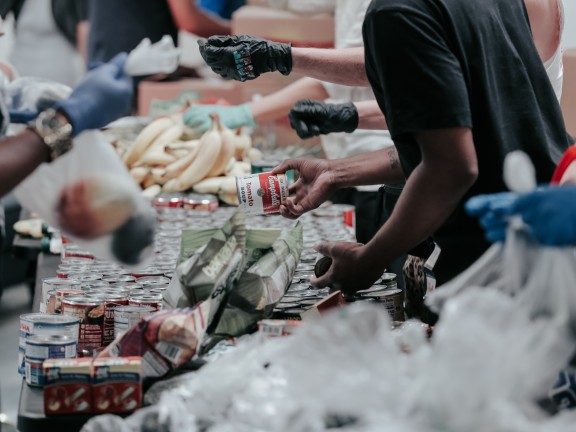State of the Safety Net 2020-2021 Report Now Available

In a time of crisis, the Montgomery County safety net system responded with agility and a call for long overdue investments in the sector and the people who staff it.
HealthSpark Foundation is pleased to share, on behalf of our community partners, the State of the Safety Net 2020-2021 Report and two-page Fact Sheet. This report is a culmination of survey findings from spring 2020 and 2021, when the Foundation surveyed nonprofit leaders from the Montgomery County safety net system on the impact of the pandemic on their nonprofit's operations, programs, staff, and board. The report highlights the adaptations implemented and lessons learned, and provides a number of calls to action for policymakers, funders, and board members wishing to build a more just and financially resilient social safety net.
As our community moves into recovery and rebuilding from the impacts of the pandemic, we are in a singular historic moment to utilize our collective lessons learned from the past year to rebuild a better system than before. "We have a tremendous opportunity to advocate and innovate for the systems, policies, and funding structures that will create a more resilient safety net," says HealthSpark President and CEO Russell Johnson. "We hope this report spurs our community partners in government, philanthropy, business, and the social sector to act together to rethink our policies, retool our funding formulas, and make the substantial changes needed to address longstanding racial and social inequities that are so pressing to our community."
Our findings from the survey denote the remarkable flexibility with which the sector responded, as well as the continued challenges of burnout and system strain, the impact of historic disinvestment in the sector, and the necessity of addressing longstanding systemic inequities if we truly aim to rebuild a better safety net.
About the survey and respondents
The online survey included responses from a representative group of nonprofits in the social safety net, including those focusing on food security, housing and homelessness, behavioral health, senior services, benefits assistance, services for persons with disabilities, workforce development, transportation, victim assistance, violence prevention, substance use, and childcare, among others. There were 57 respondents in 2020 and 42 in 2020; in 2021, 19% of organizations were headed by a person of color. The survey was designed and analyzed by Capacity for Change, LLC.
Key themes
The survey data over both years offer the ability to analyze both how the system responded in the early days of the pandemic, as well as how the sector adapted over the last year to changes in funding, demand for services, safety protocols, and other factors impacting operations. The key takeaways included:
- Adaptability and a new focus on preparedness: Providers exhibited tremendous flexibility in initial and ongoing responses. Organizations adopting planning practices such as strategic planning, development planning, and program evaluation were best prepared to respond to the crisis and are best positioned to head into the next phase. In response, nonprofits need funders to adopt more flexible funding practices and increase funds as service demands continue, and for boards to support planning efforts and investments in the infrastructure of organizations.
- Financial stabilization overall, but disparities across race continue: Since 2020 when uncertainty was high, providers overall have been able to stabilize their financial picture due to the influx of federal and private funding. However, organizations led by persons of color are under-resourced compared to their counterparts, and need policymakers to listen to their needs and invest directly in their capacity.
- Burnout is at a code red: Burnout and stress are at an all-time high for nonprofit staff, and management is deeply concerned about the capacity to retain and recruit a qualified workforce due to the historic lack of livable wage employment and necessary benefits, and the overwhelming demands placed on service providers. Funders and particularly policymakers need to prioritize retooling state, federal, and county funding formulas in order to ensure contracts for social services pay a livable wage, offer appropriate benefits for workers, and provide funding to staff programs sufficiently.
- Coordination and trust are crucial to rapid response: By 2021, networks and partnerships are commonly understood to be essential for providing effective services and for sustaining services. Nonprofits and boards should actively seek to build strong relationships with others in the community, as should policymakers and funders.
- Incremental progress on addressing racial disparities, but more work is needed: While most respondents reported taking some small steps to begin to address racial disparities within the safety net sector, more work is needed to ensure these actions take root and that providers don't lose momentum in the coming months and years. Increasing board member diversity remains a primary priority and challenge for nonprofits.
- Capacity-building needs point to flexible funding, community engagement, and operations: Respondents are directly calling government and private funders to provide multi-year general operating support grants and increase flexibility overall. As well, capacity-building needs center on increasing opportunity for diverse community engagement and support in building the capacity of board members to engage in strategic planning and fundraising.
A call to action for policymakers, funders, and boards
In light of these learnings, nonprofit respondents noted a number of opportunities for policymakers, funders, and board members to act that will better support the safety net system's capacity to withstand this crisis and build a stronger foundation moving forward. The top calls to action include unrestricted, multi-year funding; an increase in financial support to address sustained upticks in service demand; and the need to pay (and ensure contracts offer) a living wage to staff. Other responses including funding to upgrade building systems, including technology and facilities; for funders and others to act as conveners and promoters of best practices; and to actively promote the value of the safety net to the broader public.
Respondents noted a variety of capacity-building needs to respond to the varying lessons learned through the last year. The sector as a whole has limited accessibility for diverse populations, and so providers have requested support in identifying strategies to better meet the needs of non-English speaking clients, examples of authentic consumer engagement to inform services, help in building social media/web/ internet presence, and support in engaging law enforcement, faith-based coalitions, and other stakeholders often working parallel to social services.
Finally, board members take note- nonprofits have noted that board management is an area where work is needed. Respondents identified the need for assistance in diversifying the board, in building fundraising skills among board members, and in building strategic planning knowledge and skills among board members.
For more insights, download the State of the Safety Net 2020-2021 Report and two-page Fact Sheet below.


